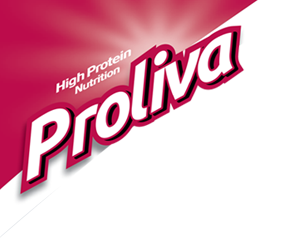Exercise damages the body and depletes nutrients and energy. Proper post-exercise nutrition can be restorative and supportive of energy and muscle recovery. Carbohydrates and creatine help restore energy reserves, and protein and amino acids can help the muscles adapt to mechanical damage and grow bigger. However, inflammation and oxidative damage can limit muscle adaptations, in addition to making joints sore. A lot of adaptation happens overnight, adding to the many performance reasons why sleep is restorative.
This slideshow looks at the trends and products supporting this market evolution. It was developed from the SupplySide West 2018 workshop, “Nutritional Strategies for Exercise Recovery.”
1. Nutritional Strategies for Exercise Recovery
Speakers: Richard J. Bloomer, Ph.D., dean of the School of Health Studies at the University of Memphis; Jay R. Hoffman, Ph.D., professor at the University of Central Florida; Steve Myers, senior editor for Informa Health & Nutrition.
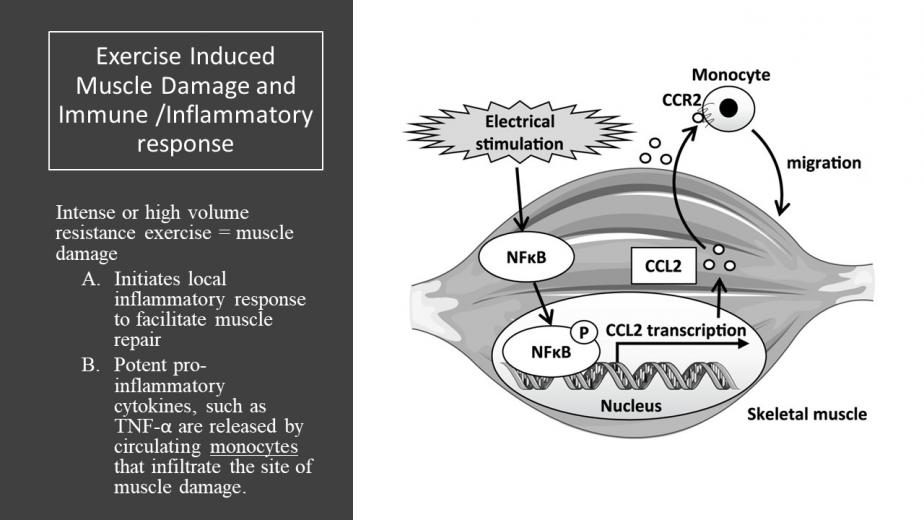
2. Exercise-induced muscle damage and performance declines
Hoffman outlined the importance of recovery from damaging exercise, detailing the effect of inflammation on the muscles and referencing published research showing performance declines in subsequent workouts inside of a 48-hour recovery window (Int J Sports Physiol Perform. 2015 May;10(4):436-9 .)
He explored the power of protein to protect muscle and encourage its development. One study on NCAA Division One football players in Iowa found consuming protein shakes following a muscle-damaging exercise protocol appeared to protect the muscle (Clin J Sport Med. 2013 Sep;23(5):365-72 .)
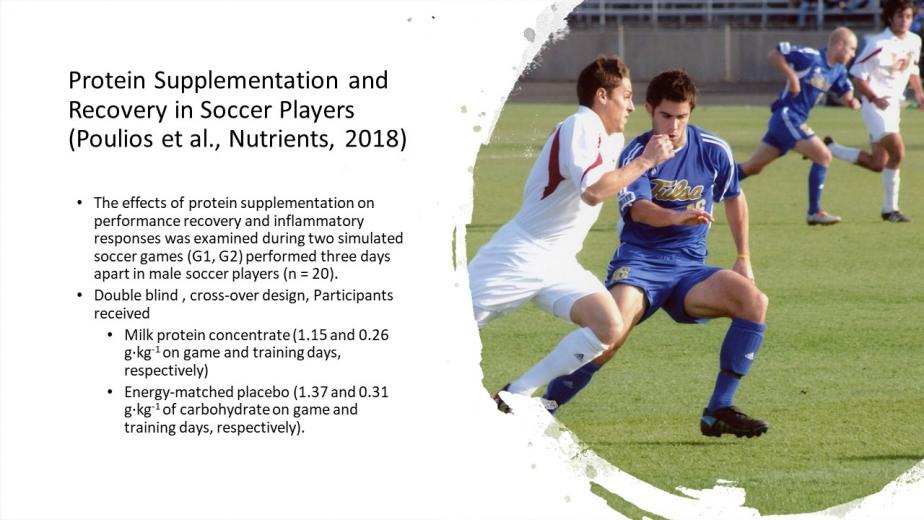
3. Protein and amino acids to the rescue?
Hoffman noted recent research on branched chain amino acid supplementation following muscle-damaging exercise in resistance-trained males generated mixed results (Nutrients. 2018 Oct; 10(10): 1389 .) The BCAA group had less soreness and lower creatine kinase (biomarker for muscle damage), compared to placebo, but there were no differences in muscle or exercise performance.
Greek researchers studied male soccer players taking protein supplementation (milk protein concentrate) and playing two games three days apart (Nutrients. 2018 Apr 16;10(4).) They found reduced speed (3 to 17 percent), knee flexor strength (12 to 23 percent) and jumping performance (3 to 10 percent) for both supplement and placebo groups in the second game. While there was no significant difference for the supplement in terms of delayed onset muscle soreness (DOMs), leukocyte count or creatine kinase levels, protein supplementation did significantly speed up recovery of protein and lipid peroxidation markers after both games.
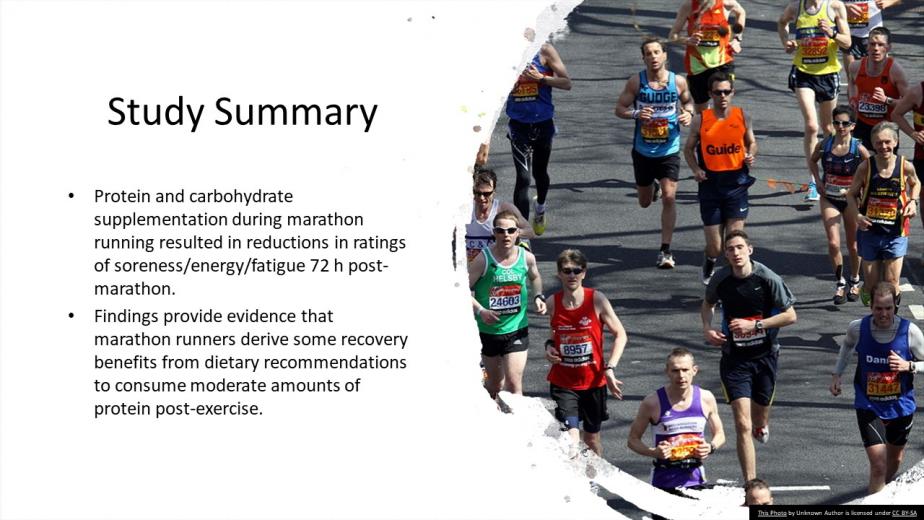
4. Protein plus carbohydrates
If protein intake following exercise can improve aspects of recovery, adding energizing carbohydrates should synergistically amplify recovery benefits, right? Hoffman detailed a 2018 study of marathon runners (Nutrients. 2018 Mar; 10(3): 333 ) as support for this macronutrient combo.
Compared to runners ingesting only carbs during the marathon, male and female runners who took a combo of protein and carbs during the run experienced less soreness and fatigue in the 72 hours post-race.
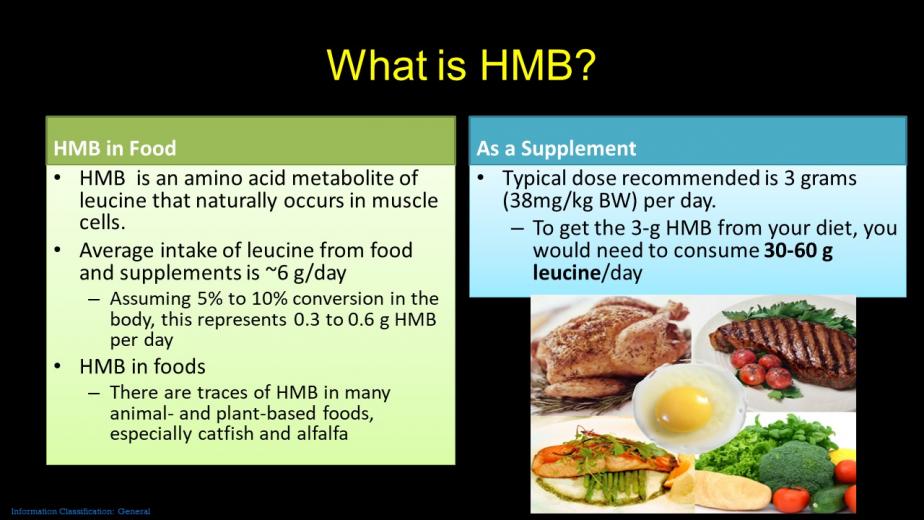
5. HMB for muscle growth and protection
Muscle protein synthesis (MPS) is the process of building new muscle fibers, and the amino acid leucine is theorized to trigger of MPS. When MPS outpaces muscle protein breakdown, muscle grow.
HMB (beta-hydroxy beta-methylbutyrate) is a metabolite of leucine, making it an emerging target for study of muscle growth and recovery. Hoffman reported HMB upregulates MPS, via the mTOR (mammalian target of rapamycin) pathway, and modulates protein breakdown. HMB also appears to address inflammatory challenges, specifically the signaling molecule TNFa (tumor necrosis factor-alpha) to the muscles following damaging exercise.
A University of Central Florida study on resistance-trained men showed HMB-free acid (HMB-FA) supplementation better attenuated TNFa and TNF receptor expression during recovery, compared to placebo and cold water immersion (J Appl Physiol (1985). 2013 Oct 15;115(8):1173-82 .) The researchers concluded HMB can help reduce recovery time.
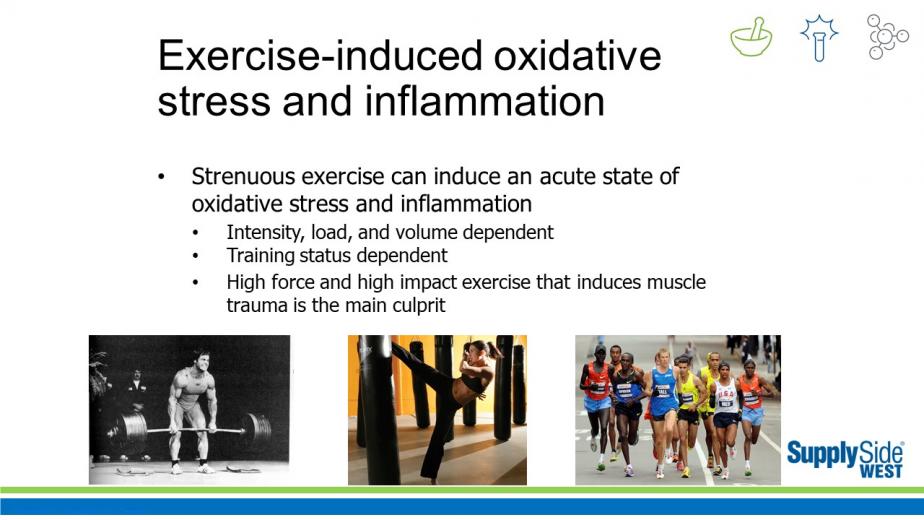
6. Exercise-induced inflammation and oxidative stress
Bloomer noted exercise has numerous positive effects on the body, including reduced systemic inflammation and blood pressure, and improved endogenous antioxidant defense, body composition and metabolism.
However, he noted when the production of reactive oxygen and nitrogen species (RONS) outpaces the body’s antioxidant defense, a state of oxidative stress results. This type of stress can lead to inflammation. He advised some level of inflammation and RONS is natural and even beneficial, but the goal in recovery should be balancing these potentially harmful consequences of exercise.
He explained the degree of oxidative stress depends on the intensity of exercise, volume of exercise, training status of individual and nutritional status of individual.
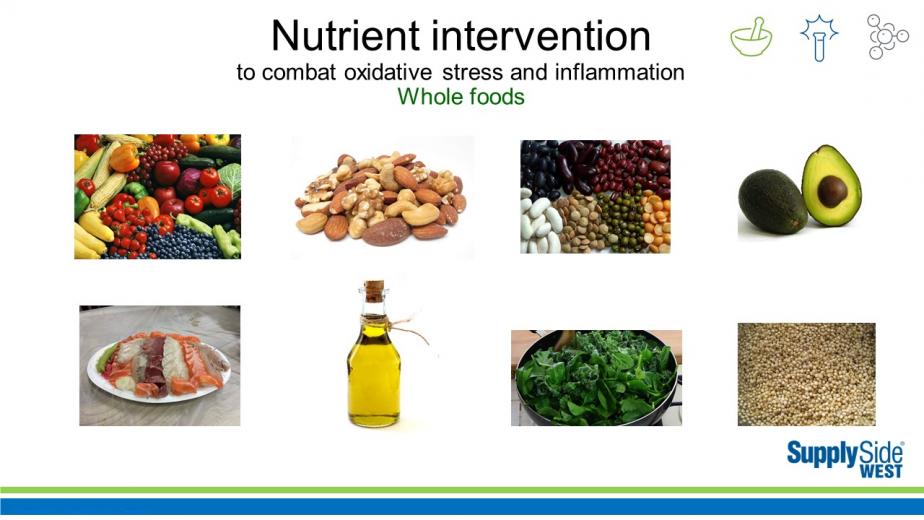
7. Nutrients to address inflammation and oxidative stress
Bloomer reported regular exercise reduces inflammatory biomarkers (J Phys Act Health. 2018 Jan 1;15(1):64-71 .) Both low- and high-intensity exercise produce these results, but high-intensity interval training (HIIT) may be produce the greatest reductions. Exercise also stimulates production of myokines, muscle cell signaling proteins that can limit inflammatory signaling molecules called cytokines.
However, a range of healthy foods have been shown to help manage inflammation and oxidative stress, including fruits and vegetables (polyphenols), nuts, legumes, avocado, fish (omega-3s), greens and healthy oils.
8. Dietary supplements for recovery
In addition to whole foods, many dietary ingredients used as supplements can help support recovery from damaging exercise.
Curcumin can limit post-exercise inflammation and oxidative stress, thereby reducing muscle soreness and damage.
Alpha lipoic acid can alter the inflammatory response to exercise, enhance muscle repair, decrease oxidative stress following exercise and enhance antioxidant defense.
Tart cherry can accelerate recovery by reducing post-exercise muscle soreness, inflammatory response and oxidative stress.
Omega-3 DHA (docosahexaenoic acid) and EPA (eicosapentaenoic acid) can lower oxidative stress, muscle damage and inflammation following exercise. Limiting strength and range of motion loss.
Methylsulfonylmethane (MSM) can alter inflammatory response, reduce muscle soreness and fatigue, limit oxidative stress and promote quicker return to force production following exercise.
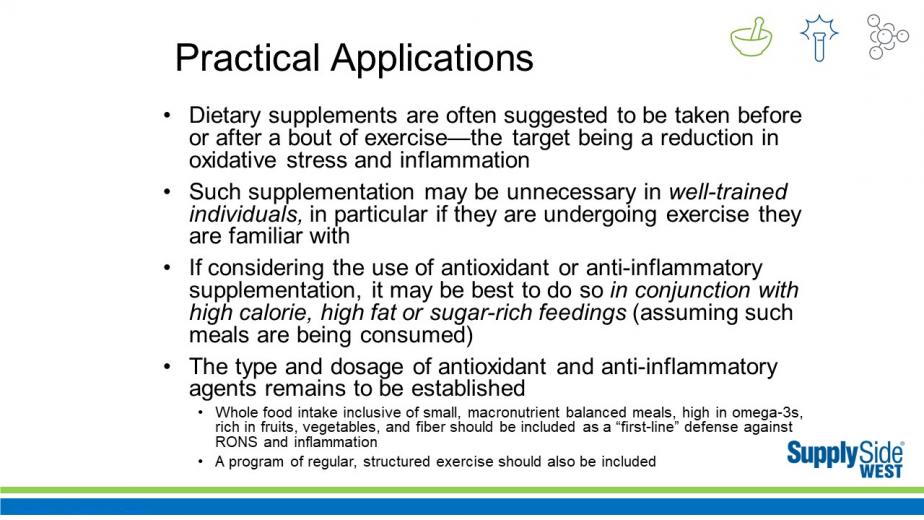
9. Applications and considerations
Bloomer laid out considerations for why, when and how antioxidant andante-inflammatory ingredients could be used to promote recovery and gains, but advised formulators to carefully assess the supporting research behind desired benefits:
Understand the difference between statistical significance and physiological significance
Understand the physiological relevance of outcome measures (e.g., CK).
Carefully review the literature and make certain that product formulation contains the research-supported dosage
Consider the form of the ingredient used in order to maximize absorption
Make sure that the claims being made can be supported by the scientific literature which is cited
Consider the scientific evaluation of the finished product through a third-party research group
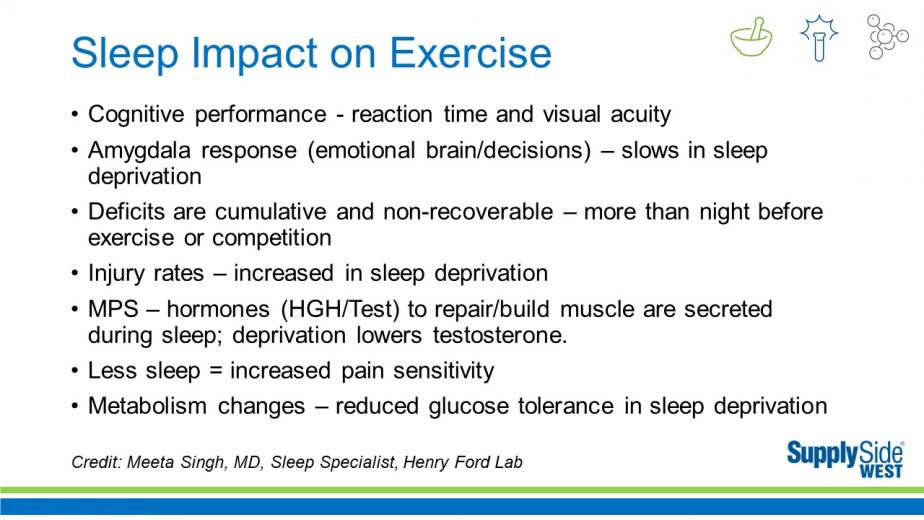
10. Sleep Matters
“Sleep and recovery are integral to athletic performance; [sleep] is often the most ignored aspect,” said Meeta Singh, MD, sleep specialist at Henry Ford Sleep Lab.
Myers highlighted some sleep-sports facts to consider:
The average adult needs 7 to 8 hrs. of sleep, but athletes need more, around 9 to 10 hrs. of sleep. (Sleep. 2011 Jul 1;34(7):943-50 .)
Home field advantage may be scientific if the away team travels across time zones. Playing at peak Circadian rhythms affect critical elements of performance, and athletes will play best at their peak performance time of day. (Sleep. 1997 May;20(5):362-5 .)
Poor sleep can negatively impact cognitive performance (reaction time, visual acuity); amygdala response (emotional brain/decisions); injury rates; pain sensitivity; and metabolism (reduced glucose tolerance); and muscle building (hormones to repair/build muscle are secreted during sleep.) Deficits from sleep deprivation are cumulative and non-recoverable, so good sleep is important beyond just the night before competition/performance.
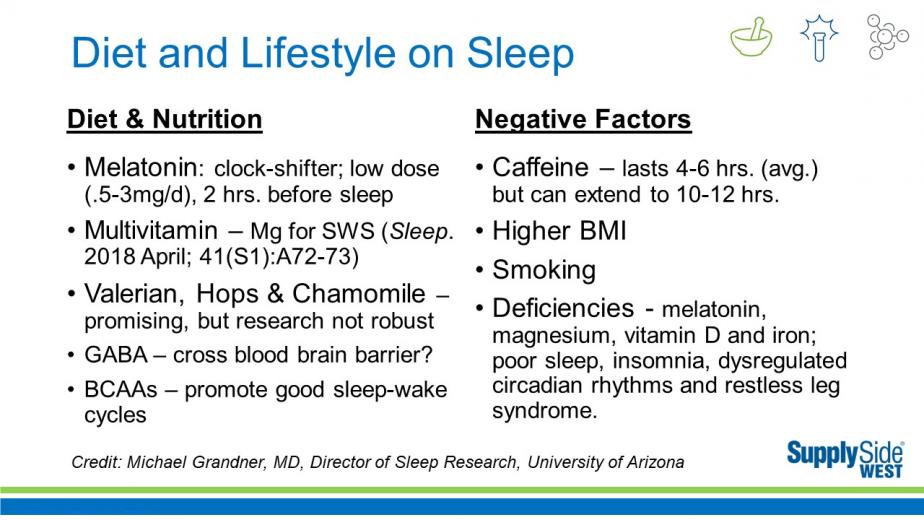
11. Diet and lifestyle factors
Myers outlined several dietary and lifestyle factors that can influence sleep quality and timing. The trick to managing the dietary factors is to consider dose and timing, and supplementation can help address nutritional deficiencies.
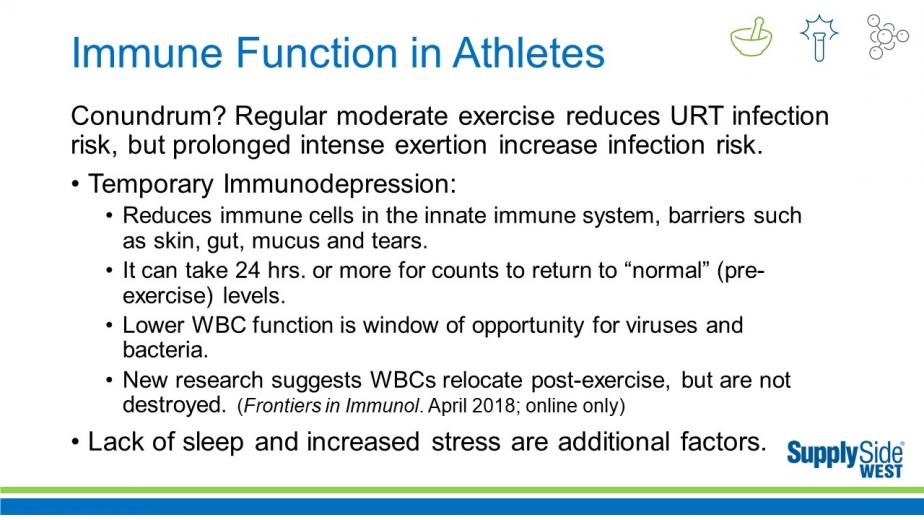
12. Managing immune function in recovery
While exercise results in an overall positive effect on immune function, intense exercise can result in a temporary period of immunospression and leave atheltes susceptible to upper respiratory infections.
Some dietary ingredients that can help during this post-exercise period include:
Plants – polyphenols
Probiotics – gut mucosal immunity; may reduce URTIs.
Micronutrients – vitamins A,B,C & D; minerals iron & zinc.
Beta-Glucans – Wellmune (Kerry) in athletes: improve mucosal immunity; reduce incidence & severity of URTIs.
